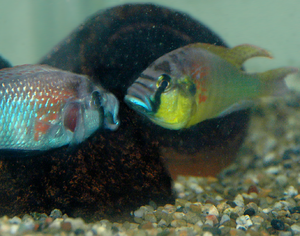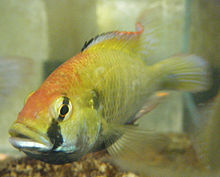- Astatotilapia
-
Astatotilapia 
Astatotilapia burtoni
Systematik Ordnung: Barschartige (Perciformes) Unterordnung: Lippfischartige (Labroidei) Familie: Buntbarsche (Cichlidae) Unterfamilie: Pseudocrenilabrinae Tribus: Haplochromini Gattung: Astatotilapia Wissenschaftlicher Name Astatotilapia Pellegrin, 1904 Astatotilapia ist eine Gattung aus der Familie der Buntbarsche (Cichlidae), die für eine Art (A. desfontainesi) aus Oasen Nordafrikas aufgestellt wurde. Ihre Gültigkeit und die einzubeziehenden Arten sind in der Literatur umstritten.
Inhaltsverzeichnis
Validität
Pellegrin[1] hatte beim Aufstellen der Gattung übersehen, dass einige Jahre zuvor bereits Hilgendorf[2] eine taxonomische Einheit für Fische geschaffen hatte (nämlich Haplochromis), denen auch Astatotilapia entsprach. Regan[3]zog daraufhin Astatotilapia ein. Greenwood[4] revalidierte die Gattung, definierte sie neu und dehnte sie auf viele weitere Arten aus, obwohl er bereits hier zugeben musste, dass Astatotilapia keine monophyletische Einheit bildet. Van Oijen[5] faßte die Kritik an dieser und anderen von Greewood aufgestellten Gattungen zusammen, die hauptsächlich aus Überlappungen mit neu gefundenen Arten und der Unmöglichkeit, bereits existente Arten in die eine oder andere Greenwood'sche Gattung einzugruppieren, besteht. Da Astatotilapia seither nicht neu definiert wurde, gilt der Rat, den Namen vorerst nicht zu verwenden.
Merkmale
Nach gängiger Vorstellung werden "Astatotilapia"-Arten 9 bis 15 cm lang, Weibchen bleiben etwas kleiner. Daneben sind sie meist schlicht gefärbt, während die Männchen auffallend farbig sind. Der Körper ist von typischer Buntbarschgestalt und seitlich etwas abgeflacht. Der Kopf ist groß und bullig. Von der nah verwandten Gattung Haplochromis unterscheidet sich Astatotilapia durch die Zähne in den äußeren Zahnreihen, die bei Astatotilapia einspitzig oder zweispitzig sind und seitlich nicht zusammengedrückt oder schräg abgestumpft. Die Zähne der inneren Zahnreihen sind klein und dreispitzig. Auf der Pharyngealia sind die mittleren Zahnreihen mit vergrößerten, manchmal mahlzahnartigen Zähnen besetzt. Die Schwanzflosse ist abgerundet. Alle Astatotilapia-Arten sind Allesfresser und Maulbrüter. Auf der Afterflosse tragen sie 3 bis 9 Eiflecke.
- Schuppenformel: mLR 28-30
Etymologie
Pellegrin, der die Gattung definiert, bildet den Namen aus den Worten Gr.: „astatos“ = unstabil + Tilapia (afrikanische Buntbarschgattung). Der erste Namenteil bezieht sich auf die Zähne der Männchen in den äußeren Kieferzahnreihen, die wie die Weibchen zunächst zweispitzig sind, aber im Laufe der Aduleszens durch einspitzige ersetzt werden.
Arten und Verbreitung
nach Greenwood (1979):
- Astatotilapia bloyeti (Sauvage, 1883) Küstenflüsse Tansanias.
- Astatotilapia burtoni (Günther, 1894) Tanganjikasee und mit ihm verbundene Flüsse (Lukuga u.a.)
- Astatotilapia calliptera (Günther, 1894) Malawisee, Chiuta-See, Chilwa-See, unterer Sambesi, Buzi, Pungwe und Save.
- Astatotilapia desfontainesi (Lacepède, 1802) Quellen in Oasen in Algerien und Tunesien.
- Astatotilapia dolorosa (Trewavas, 1933) Chambura river.
- Astatotilapia flaviijosephi (Lortet, 1883) Jordan, See Genezareth.
- Astatotilapia stappersii (Poll, 1943) Tanganjikasee und mit ihm verbundene Flüsse.
- Astatotilapia swynnertoni (Boulenger, 1907) Buzi und unterer Pungwe, südwärts bis zum Save in Mosambik.
- Astatotilapia tweddlei (Boulenger, 1907) Chiuta-See, Chilwa-See und zuströmende Flüsse.
nach Greenwood (1980)[6] wurden zahlreiche weitere Arten zu Astatotilapia aus den Seen Edward, George, Kivu, Kyoga, Nabugabo und Victoria gestellt, im einzelnen sind dies:
- Astatotilapia aeneocolor (Greenwood, 1973) Georgsee.
- Astatotilapia barbarae (Greenwood, 1967) Victoriasee.
- Astatotilapia brownae (Greenwood, 1962) Victoriasee.
- Astatotilapia cinerea (Boulenger, 1906) Victoriasee.
- Astatotilapia eduardi (Regan, 1921) Edwardsee.
- Astatotilapia elegans (Trewavas, 1933) Edwardsee, Georgsee.
- Astatotilapia engystoma (Trewavas, 1933) Edwardsee.
- Astatotilapia lacrimosa (Boulenger, 1906) Victoriasee.
- Astatotilapia latifasciata (Regan, 1929) Kyogasee.
- Astatotilapia macrops (Boulenger, 1911) Victoriasee, Victorianil ?.
- Astatotilapia macropsoides (Greenwood, 1973) Edwardsee, Georgsee.
- Astatotilapia martini (Boulenger, 1906) Victoriasee.
- Astatotilapia megalops (Greenwood & Gee, 1969) Victoriasee.
- Astatotilapia melanopus (Regan, 1922) Victoriasee.
- Astatotilapia oregosoma (Greenwood, 1973) Georgsee.
- Astatotilapia pallida (Boulenger, 1911) Victoriasee, Victorianil ?.
- Astatotilapia piceata (Greenwood & Gee, 1969) Victoriasee.
- Astatotilapia schubotziella (Greenwood, 1973) Georgsee, Edwardsee ?.
- Astatotilapia velifer (Trewavas, 1933) Nabugabosee.
Literatur
- Claus Schaefer, Torsten Schröer (Hrsg.): Das große Lexikon der Aquaristik. Ulmer Verlag, Stuttgart 2004, ISBN 3-8001-7497-9.
- Günther Sterba: Süsswasserfische der Welt. Urania-Verlag, 1990, ISBN 3-332-00109-4
- ↑ Pellegrin, J. (1904): Contribution à l'étude anatomique, biologique et taxinomique des poissons de la famille des Cichlidés. Memoires Societe Zoologique de France, 16 (2-4): 41-400.
- ↑ Hilgendorf, F. M. (1888): Fische aus dem Victoria-Nyanza (Ukerewe-See), gesammelt von dem verstorbenen Dr. G. A. Fischer. Sitzungsberichte der Gesellschaft Naturforschender Freunde zu Berlin, 1888: 75-79.
- ↑ Regan, C. T. (1922): The classification of the fishes of the family Cichlidae. II. On African and Syrian genera not restricted to the great lakes. Annals and Magazine of Natural History, (9) 10 (57): 249-264.
- ↑ Greenwood, P. H. (1979): Towards a phyletic classification of the `genus' Haplochromis (Pisces, Cichlidae) and related taxa. Part 1. Bulletin of the British Museum (Natural History) Zoology, 35 (4): 265-322.
- ↑ van Oijen, M. J. P. (1996): The generic classification of the haplochromine cichlids of Lake Victoria, East Africa. Zoologische Verhandelingen, Nationaal Natuurhistorisch Museum, Leiden, 302: 57-110.
- ↑ Greenwood, P. H. (1980): Towards a phyletic classification of the `genus' Haplochromis (Pisces, Cichlidae) and related taxa. Part II; the species from lakes Victoria, Nabugabo, Edward, George and Kivu. Bulletin of the British Museum (Natural History) Zoology, 39 (1): 1-101.
Weblinks
- Astatotilapia auf Fishbase.org (englisch)
Wikimedia Foundation.

